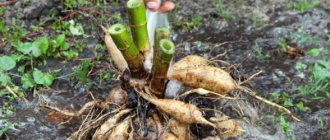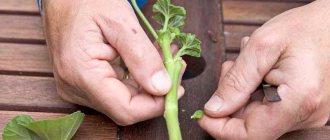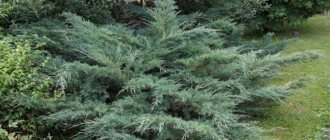Reproduction of peonies by dividing the bush
You can divide a peony bush from the age of five, but the optimal age is 6-7 years. Bushes are dug up in the fall. You need to choose a time so that the buds underground have already formed, but the growth of roots has not yet begun. This usually occurs in mid-August. Peonies divided later than the end of September do not take root well.
The rhizomes need to be washed from the ground and dried in a shady place for 4-6 hours. Using a knife and chisel, the bush is cut into sections. Each should have 3-5 buds. Small trimmings with 1-2 buds will also be useful; they can be grown in the school.
By dividing the rhizome, you get several copies of young peonies at once
All parts of the plant obtained as a result of division are inspected, cleaned of rot, excess roots are cut off, leaving 2-3 on each division, the rest are shortened to 10-12 cm. Then they are treated with any fungicide, the sections are powdered with charcoal and kept in the shade for a day. After which the cuttings are immediately planted or dipped in a clay mash and dried (if the seedlings are intended to be transported).
Read more about dividing and replanting peony bushes in our article.
Reproduction of daylilies in autumn
Daylilies can be divided in the ground, but in this case you can only divide the bush into 2-3 parts. And part of the cuttings will be cut in half with a shovel. if the variety is not rare and you just need to replant the bush, then you can do it this way, but if you need to get individual cuttings of a rare variety, then the bush needs to be dug up completely.
Daylily division order
Rinse the dug-out bush well with water, remove old dry leaves and begin dividing.
With daylilies, the rule is simple: the number of buds, the number of divisions.
This rule, however, applies only to edge fans. The central ones, as a rule, grow so crowded (densely) that it is difficult to separate them individually, and they are planted in one group.
in the photo: 1. digging up a daylily bush, 2. washing the daylily roots from the soil, 3. separating a division from the bush, 4. a finished daylily division
Using a clean, sharp knife, separate one fan at a time from the bush. Thus, cut the required number of sections, clean them and cut the leaves in half.
The leaves of the finished daylily division are cut to the length of half a fan.
Daylilies do not need to be dried. If you receive cuttings with already dried roots, then soak them in water for several hours before planting.
Is it possible to separate a fan from a daylily bush that grows separately from the main bush?
Daylilies often have a single fan growing next to the main bush. Many gardeners, without thinking twice, cut off this fan with a shovel, hoping to get a full-fledged plant. However, most often such a division does not have a root system. Daylily quite often produces single stolons away from the bush, but it takes time for a normal root system to grow. Therefore, before digging up such a fan, make sure that it has its own roots. To do this, carefully dig up the daylily and, only after making sure that you can take the shoot with its roots, separate it from the bush.
After digging up the daylily bush, it became clear that the fan growing to the side of the bush did not have a sufficient number of its own roots.
Propagation of peonies by root cuttings
Root cuttings are non-standard pieces of roots obtained from dividing a peony bush in the form of pieces of roots with 1-2 buds. They are planted on ridges with fertile, loose soil (in a shkolka) according to a 15x15 cm pattern.
However, it is worth considering that even in the best conditions, no more than 80% of cuttings take root, so this method of propagating peonies should be considered as a backup. For example, if after dividing the bush there are such pieces of roots that it is a pity to throw away.
Peony root cuttings must have at least 1-2 buds
You will find more about peony propagation by cuttings in this article.
Reproduction by pruning
This is a highly productive method used for herbaceous varieties. With its help, a large amount of planting material is obtained. A 5-7 year old plant is used as a mother bush.
Method of propagation by pruning:
- The bush pruned for the winter is opened.
- The upper part of the plant is cleared of soil.
- Surface roots are exposed.
- They are cut 5-7 cm below the renewal buds.
- The remaining rhizome is rubbed with coal, covered with soil and mulched with sawdust.
- The resulting cuttings are placed in separate places.
The mother plant is restored in summer or autumn. During this period, it can be pruned again.
Reproduction of peonies by vertical layering
This is an interesting method, but it is not suitable for all varieties of peonies. As soon as the soil thaws after winter, it is raked away from the bush, exposing the underground buds. A box without a bottom, 35-45 cm high, is placed on the rhizome. A 12-centimeter layer of a loose mixture of soil, sand and peat (3:1:1) is poured into it.
Peony propagation scheme by layering
Once a week, add a fresh portion of the mixture until it reaches the edges of the box. At the end of September, the box is removed, the soil is raked and the stems are cut off. Those areas of the shoots on which buds have formed are immediately planted in the school.
Soil for planting peonies
Now about the agricultural technology of peonies. This is a demanding crop of the Ranunculaceae family.
| The peony itself is a poisoner; it will not grow in its place a second time. |
Choose all organic fertilizers later. And when planting, based on many years of experience in growing flowers, simpler soil is preferable: black soil, possibly with ash. You don't need peat under the peony, just a little sapropel. The soil should be neutral, unlike hosta, where it needs to be acidic. Mineral phosphorus and mineral potassium are excellent fertilizers. AVA vitreous is also suitable: one-year-old, two-year-old, three-year-old, or ordinary superphosphate with the addition of ash in an approximate ratio of 1:1, 1:2, that is, 100 grams of superphosphate and 100-200 grams of ash. All this is mixed with chernozem, and the prepared plot is planted.
Photo: It is better to plant peonies in black soil.
Planting peonies in the ground
It is important not to bury the peony when planting. There should be no more than 5 cm of soil above the buds. Deepening leads to a lack of flowering. It’s better to plant it smaller, the hole will definitely sag, and then you can add more to it. If a flower is planted shallowly, takes root and begins to grow, which should not happen, but happens in warm autumn, the buds peek out of the ground, and they need to be covered with a mound of a mixture of sand and coal or sand and ash. If a bud grows out of the soil ahead of time, this is not a disaster.
Photo: Do not bury the peony too much, otherwise it may not bloom.
Buds removed from varieties that do not divide well are planted in comfortable conditions in beds, preferably in a greenhouse or greenhouse with careful subsequent care. From the standard peony usually grows in 1-2 years. More often it is necessary to divide hybrids this way because of their structure: a bouquet of buds, then the neck, and then the root system. All this has to be cut, the buds removed and grown separately.
Propagation of peonies by stem cuttings
This is the most technically difficult method. It is used when seedlings with completely new roots are needed. But this method of propagation is not suitable for all types of peonies. Interspecific hybrids, for example, are generally impossible to propagate in this way. Tree peonies are most often propagated from stem cuttings.
Interspecific hybrids of peonies cannot be propagated by stem cuttings.
The shoots are cut off before the flowers bloom, they are cut into cuttings, leaving a pair of internodes on each. The leaves are also cut off, leaving only part of one leaf on each cutting. The cuttings are soaked in any growth stimulant (according to the instructions for the preparation) and planted in a greenhouse obliquely at a distance of 10 cm from each other.
Usually 25 cm is left between the rows. The cut from the bottom leaf should be in the soil. The air humidity under the film should always be maximum, then about 20% of the cuttings will give roots.
How do peonies reproduce?
These lush homemade flowers are easy to propagate. There are several ways to do this.
- Dividing the bush. This method is good because when the bush is propagated, all the characteristics of the variety are preserved. But it can only be used for adult bushes.
- Stem cuttings. The method is not easy, it preserves varietal characteristics, but is not used for propagating hybrids.
- Root cuttings. Varietal characteristics are preserved in hybrids, so the method is quite popular.
- Pruning. The method is not complicated, varietal characteristics are preserved, but is used only for adult plants.
Tree peonies
Propagation by seeds is placed in a separate category. This perennial can be propagated using this method, but it is not often chosen, since the characteristics of the variety are not preserved, and not all varieties can have seeds.
Propagation of peonies by seeds
This type of propagation is used only in selection. Each flower left on the bush usually produces seeds by the end of August. They are collected and kept in the refrigerator. In October, before the first cold weather, the seeds are taken out, soaked in a pink solution of potassium permanganate for a couple of hours, then sown on the beds. The distance between rows is 10-15 cm.
Peony seeds ripen by the end of summer
The seeds will begin to germinate the next year, but most will germinate within a year. Grown seedlings are planted according to a 20x40 cm pattern. After a year or two, the bushes are transferred to a permanent place. They will bloom only in the sixth year.
Which of these methods do you use to propagate peonies? Would you like to try something new?
Features of seasonal propagation: what is best and what methods are suitable
To successfully propagate beautiful peonies, you need to know that each method has its own suitable time of year.
in spring
In the spring, it is recommended to resort to the method of dividing the rhizome. Before dividing the peony, you need to remember that this procedure is carried out between the last days of April and the first week of May. At this time, active root growth begins.
Only in spring, early, as soon as the snow melts, do peonies reproduce using aerial cuttings. Before propagating peonies in the spring, you need to make sure that there is no risk of frost returning.
In summer
In the summer, in the last days of August, peonies can be propagated by dividing the mother plant.
in autumn
In the autumn, at the beginning of September, any propagation method can be used. Planting in open ground should be done before frost sets in. As soon as frosts begin, the seed should be kept in a warm room.
Knowing how perennial peonies reproduce, every gardener can create bright flower beds of beautiful flowers on their site. There are many ways to propagate perennial peonies; they are quite simple to implement, and young seedlings are not difficult to care for. Every flower lover can choose a method that suits him how to grow peonies. The exception is the sowing method, which is used only by experienced gardeners for selection purposes.











